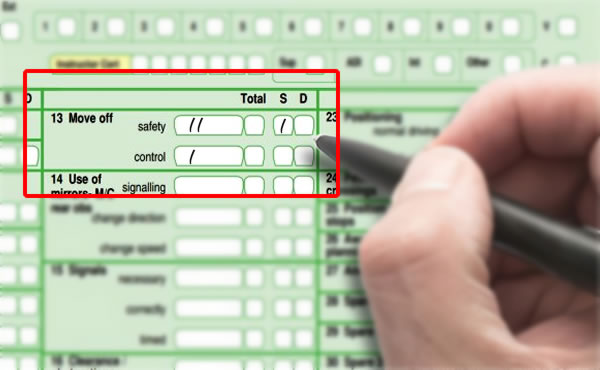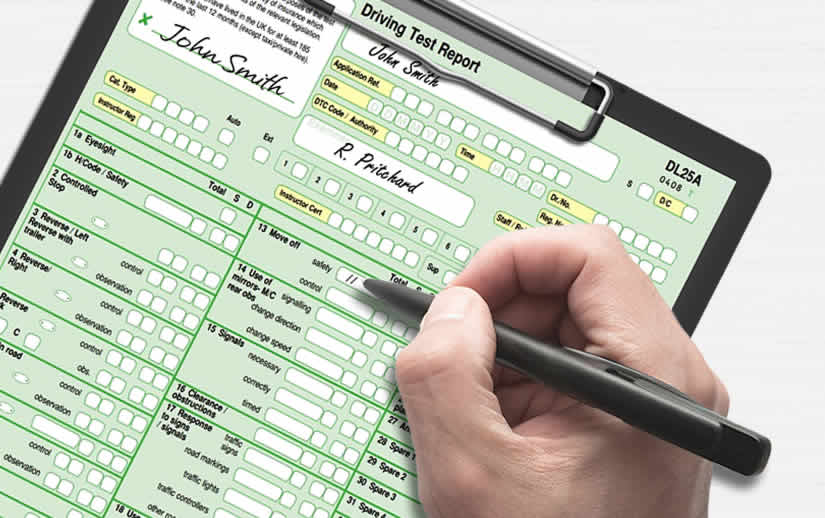Everybody that sits the practical driving test does of course want to pass, so having knowledge on many of the common driving test faults may help you to avoid making the same mistakes. Here, we’re going to take a look at the most common driving test faults when moving off.
What is Moving Off in Driving?
When learning to drive or when taking the driving test, ‘moving off’ is a procedure where the driver moves off from a parked position at the kerbside of the road. This can be either from the left or right kerb, but in this instance, we’re explaining the faults that can occur from moving off from the left side of the road.
Moving Off and the Driving Test Report Sheet
On the driving test report sheet, moving off represents box number 13. In box 13, you’ll see additional boxes that the examiner can mark that come under the ‘Safety’ and ‘Control’ categories.
‘Minor’ faults may be accumulated in the long box and tallied up in the ‘Total’ box. The ‘S’ and ‘D’ boxes represent a serious of dangerous fault, gaining just one of which will fail your driving test. You can receive up to 15 (minor) faults on your driving test and still pass, but if you continue to make the same mistakes and receive several faults under the same category, you still might fail.
Examples of Moving Off During the Driving Test
During the practical driving test, the examiner will ask that you pull up at the side of the road and move off again. This can occur several times throughout the test can may involve:
- Moving off on a level surface (from the left side of the road)
- Moving off on a level surface (from the right side of the road)
- Moving off on a hill (hill start)
- Moving off at an angle

What is the Examiner Checking When Moving Off?
The examiner is checking two main key areas and these are safety and control. The examiner is checking to ensure that you:
- Prepare the vehicle accordingly
- Make correct use of mirrors
- Observe the blind spots
- Signal when necessary
- Observe and respond appropriately to traffic and pedestrians
- Operate the vehicle’s controls to good standard
Common Driving Test Faults When Moving Off
Every year, many driving tests are failed due to test candidates not following the correct procedure when moving off. In fact, not moving off safely and a lack of control when moving off frequently make it into the DVSA’s top 10 reasons for failing a driving test.
We’ll now compare what the examiner is checking when moving off and what common faults often occur. Let’s first take a look at safety issues that can earn you fault marks on your report sheet.
Preparing the Vehicle Accordingly
When moving off from the side of the road, there is a specific order that should be followed; prepare the car, carry out safety observations, signal if necessary and only then, move off. You can read how to properly carry out this exercise by reading the moving off in an automatic car tutorial.
If you’ve forgotten to properly prepare the car and have to make adjustments after carrying out safety observations, it’s important that if there’s a delay between observations and making adjustments, that you carry out safety observations again. A lot can change on a road in a very short amount of time. A ‘minor’ fault under safety is likely to be recorded, but if it impacts another road user, it’s likely to be a serious or dangerous fault.
Make Correct Use of Mirrors
A fault will be recorded if the test candidate makes no attempt to use the vehicle’s mirrors just prior to moving off. At the very least, prior to moving off, check the internal rear-view mirror followed by the driver’s door mirror when moving off from the left side of the road.
Observe the Blind Spots
Checking the mirrors but forgetting to check blind spots prior to moving off is a common test failure. If you’re moving off from the left, the last thing you should do prior to moving off is to look over your right shoulder into the blind spot. For further information, see what is a car blind spot and how to check it.
Signal When Necessary
Failing to signal when necessary will also earn you a fault mark. Remember, a signal may be necessary if anybody may benefit to the rear or the front and this also includes pedestrians. In in doubt, you can signal regardless. Indicators usually self-cancel, but if it doesn’t, ensure you cancel your signal once you’ve moved off, else that will be another fault mark.
Signalling and the Driving Test
During the driving test, examiners are constantly checking to ensure signals are used appropriately so not to mislead or confuse other road users or pedestrians. For an understanding on when signals should and should not be used when moving off, read the should you signal when moving off tutorial.
Observe and Respond Appropriately to Traffic and Pedestrians
It’s important that you carry out good all-round observation, but it’s also important that you respond appropriately to what you see. It takes practice to correctly gauge the speed of approaching vehicles, particular when viewed from the vehicle’s mirrors. Additionally, your car’s door mirrors have convex glass fitted, meaning that objects appear further away than they really are (see types of mirrors in a car explained).
Moving off when unsafe to do so will almost certainly see the examiner marking the serious or dangerous box on your driving test report sheet.
Operate the Vehicle’s Controls to Good Standard
We’ll now move onto faults that may be marked in the ‘control’ box. Faults may be gained due to a lack of co-ordination or inappropriate use of vehicle controls such as clutch, brake accelerator or steering.
Selecting the Wrong Gear When Moving Off
Not selecting a gear or selecting the wrong gear for moving off will gain a (minor) fault. For example, leaving an automatic car in park (p) or a manual car in neutral when attempting to move off. Quite a common fault with manual test candidates is accidently putting the gear into 3rd rather than 1st when attempting to move off.
Stalling the Engine When Moving Off
Again, relating to manual test candidates, stalling the engine can be problematic. This can be related to use of incorrect gear, but is more often due to bad clutch control. Stalling the car will only result in a (minor) fault, unless the actions of the test candidate stalls in an area that is considered hazardous or dangerous. In which case, a serious or dangerous fault may be recorded.
Due to automatic cars becoming more popular and with the increase use of electric cars, all of which are automatic, stalling will become less of a problem.
Moving Off: Speed
A fault can be gained by either moving off at a speed considered too fast and potentially hazardous, or a speed that’s too slow for the conditions and results in following drivers having to adjust the speed of their vehicles.
Rolling Back
On a relatively level surface, rolling back isn’t likely to occur in an automatic car due to the creep feature, but in a manual, it’s easy to roll backwards even on a slight incline. This is likely to attract only a (minor) fault provided that the test candidate does not continuously roll back throughout the test and that when they do, they gain control of the vehicle quickly.
